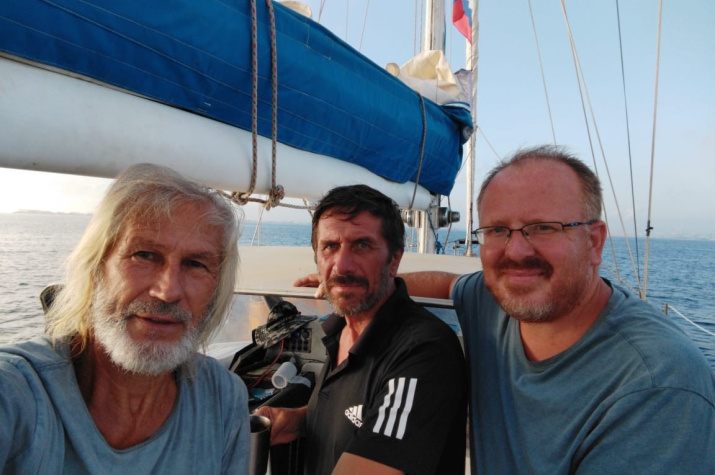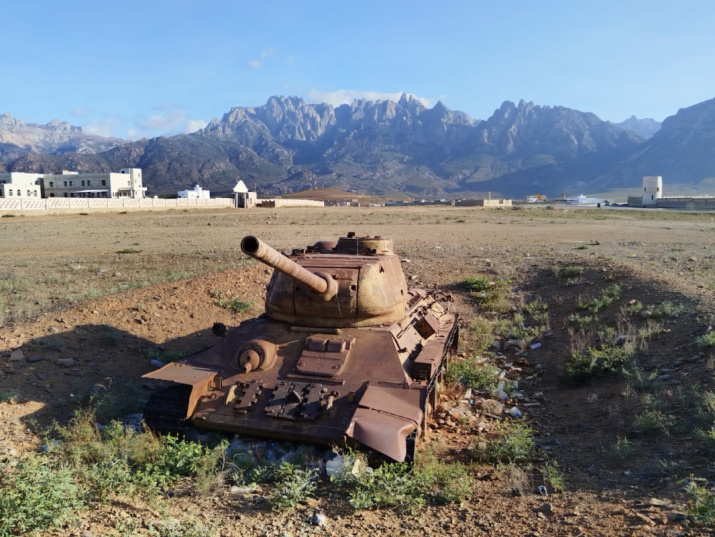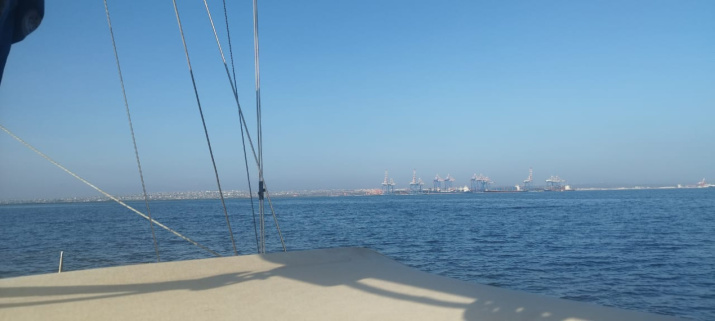The sailboat of the circumnavigation expedition of the Tomsk Regional Branch of the Russian Geographical Society successfully passed the Gulf of Aden and arrived in Djibouti on April 23. Dangerous waters, known for attacks by Somali pirates and Houthi attacks on merchant ships of unfriendly states, were left behind. The crew feels well and plans to go to the Red Sea after a short break. The expedition leader Evgeny Kovalevsky and the captain of the sailboat Stanislav Berezkin shared their impressions of the voyage with the readers of the website of the Russian Geographical Society.
On April 17, the circumnavigation left Socotra Island, where Stanislav Berezkin had to undergo a medical examination at a local clinic. They have set a course for the humanitarian corridor in the Gulf of Aden, designed to ensure navigation safety. But it took about 220 miles without any protection to reach the zone patrolled by warships from different countries.
“Two days of tension, 40-50 miles to the nearest Somali islands. The coast of Somalia is 100 miles away. Stas continues to feel physically unwell and cannot work. He refused my offer to release him from keeping watch. The three of us keep watch for four hours each," noted Evgeny Kovalevsky.
Inconveniently, the horizon is clearly visible even at night. The reason for this is the bright moonlight. The travelers met a tanker moving without lights. This was unusual.
“It is afraid of pirates, they may seize a tanker in order to sell oil, so the captain does not turn on the lights in the hope that they will pass unnoticed,” explained Stanislav Berezkin.
The circumnavigators do not turn on the on-board lights as well. There's no need to tempt fate.
“Night watch is a thriller. For the second hour, I’m staring intently into the darkness. The psychological discomfort is one of the most severe I’ve experience during the entire expedition. And we've been travelling for two years and ten months. Previously, we would wait with hope for any light in the ocean. Now light causes fear," Kovalevsky admitted.
Given the high risk of the voyage, the crew sends information about themselves three times a day to the coastal headquarters of the expedition in Tomsk. Yulia Kalyuzhnaya is constantly on duty there. Nervous tension makes itself felt, funny situations happen because of it.
“I see out of the corner of my eye that there is an object nearby to the right. I jump up abruptly and turn around. The surface of the ocean is well illuminated. I look for a few minutes along the port side into the distance. No one. I sit down and watch the equipment. I look out of the corner of my eye again and see a small ship. I jump up again and peer into the darkness. Nothing. I think there are pirates nearby, but I can't see them. And for the third time, I see a small ship in my peripheral vision. Now I turn my head slowly, not abruptly. The object becomes clearly visible. It's a clothespin hanging from the rail. In the dark, I see it behind me out of the corner of my eye, and when I turn around and look into the distance, it disappears. This clothespin-ship gave me a real adrenaline rush," laughs Kovalevsky.
On April 19, Evgeny Kovalevsky felt signs of a viral disease. But there was also good news: the sailboat finally reached the border of the security corridor.
“We see several ships moving to the east. We change course and go to Djibouti. The chances of falling into the clutches of pirates are decreasing," Kovalevsky noted.
Large vessels, noticing the yacht of the RGS’s expedition, slow down and try to avoid a meeting. In these waters, all strangers are considered a threat. The crew of the circumnavigation does not lose vigilance even in the security corridor and stays closer to the coast of Yemen, away from Somalia.
The circumnavigation vessel is still moving without lights. The danger of a pirate attack persists. On the night of April 23, Berezkin, while on watch, noticed a boat nearby that was prowling in different directions.
The weather deteriorates a little, and the ship starts rolling pretty strongly. Before dawn, the third member of the crew, Filip Alekseev, finally noticed the coastal lights in the distance. This is Djibouti.
Already in the morning, a lot of civilian ships and warships appear around. At 07:40, the sailboat anchors in the port. The journey continues.
On July 1, 2021, Siberian travelers Evgeny Kovalevsky and Stanislav Berezkin set off along the route of the first Russian round-the-world expeditions of the 19th century: Ivan Kruzenshtern’s (1803-1806), Yuri Lisyansky’s (1803-1806), Otto Kotzebue’s (1815-1818, 1823-1826), Vasily Golovnin’s (1817-1819), Fedor Litke’s (1826-1829), Faddey Bellingshausen and Mikhail Lazarev’s (1819-1921). The international project of the Tomsk Regional Branch of the Russian Geographical Society "Following the paths of Russian explorers" is dedicated to the 250th birthday anniversary of Krusenstern and the 200th anniversary of the discovery of Antarctica by Russian sailors. These events for a long time determined Russia's leadership in the development of the oceans and the discovery of new lands. You can learn more about the project and provide all possible assistance in its implementation on the website of the expedition.
Alexander Zhirnov



